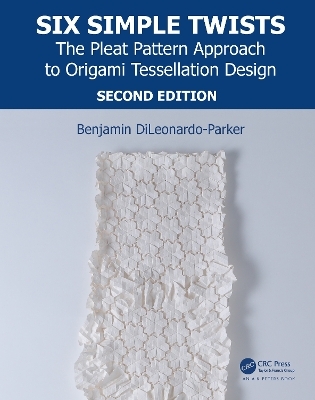
Six Simple Twists
CRC Press (Verlag)
978-1-138-31192-3 (ISBN)
In this thoroughly updated second edition, the book explores new techniques and example tessellations, with full-page images, and mathematical analysis of the patterns. A reader will, through practice, gain the ability to create still more complex and fascinating designs.
Key Features
Introduces the reader to origami tessellations and demonstrates their place in the origami community
New layout and instructional approach restructure the book from the ground up
Addresses common tessellation questions, such as what types of paper are best to use, and how this artform rose in popularity
Teaches the reader how to grid a sheet of paper and the importance of the pre-creases
Gives the reader the ability to create and understand tessellations through scaffolded instruction
Includes exercises to test understanding
Introduces a new notation system for precisely describing pleat intersections
Analyzes pleat intersections mathematically using geometrically-focused models, including information about Brocard points
Born in Pittsburgh and living in Connecticut, Benjamin DiLeonardo-Parker has an active student of origami tessellations since 2007. He has taught and exhibited at origami conventions and art shows internationally, including Chi Mei Museum (Tainan City, Taiwan), La Escuela-Museo Origami de Zaragosa (Zaragosa, Spain), The Science Museum Oklahoma (Oklahoma City, OK), the Museum of Mathematics (New York, NY), the Japan Information and Culture Center (Washington D.C.), The New Britain Museum of American Art (New Britain, CT), and the Cooper Union Gallery (New York, NY). Outside of art, Ben teaches high school mathematics to students with uncommon learning styles, and incorporates origami into his classes as often as he can. Ben approaches his artwork from a holistic standpoint, preferring to view origami as an entry into the vast network of disciplines to which it is connected. This has led him to extend his knowledge of education, engineering, mathematics, CNC fabrication, paper arts, fashion, alternative photography, and other studies. When not teaching high school math, Ben operates a workshop in Essex, CT out of which he creates artwork and runs classes on origami design, He views his practice of origami as cyclical and recursive. Origami is connected to such as vast network of disciplines, each with its own siren’s call. Each flavor, each culture, cycles back onto its own basics over and over, swirling and interacting with previous knowledge, each enhancing the others in some way.
Part I
1.00 - Why Study Pleat Patterns?
1.01 - Basics and Preparation
1.02 - How Pleat Patterns Differ from Traditional Origami
1.03 - How to Read the Diagrams and Fold Parity
1.04 - Folding Uniform Parallel Creases
1.05 - Grid Axes and How to Fold a Hexagon
1.06 - How to Fold a Triangle Grid
1.07 - Simple Pleat
1.08 - The Six Simple Twists
1.09 - Triangle Twist
1.10 - Triangle Spread
1.11 - Hex Twist
1.12 - Hex Spread
1.13 - Rhombic Twist
1.14 - Arrow Twist
1.15 - Anatomy of a Molecule
1.16 - Pleat Intersection Notation
Part II
2.00 - How to Use the Six Simple Twists
2.01 - 32nd’s Grid
2.02 - Locking and Unlocking Pleats
2.03 - Triangle Twist Tessellation
2.04 - 3.6.3.6 Tessellation
2.05 - Tessellation Basics
2.06 - Applying Tessellation Knowledge Folding
2.07 - Triangle Weave Tessellation
2.08 - 3.6.3.6 Weave Tessellation
2.09 - 6.6.6 Hexagonal Failing Cluster
2.10 - Modifications
2.11 - Backtwisting
2.12 - Twist Handedness and Pleat Symmetry
2.13 - Pleat Flattening
2.14 - Triangle Twist Tessellation with Flattened Pleats
2.15 - Hidden Circles Pattern
2.16 - Rhombic Twist Tessellation
2.17 - Rhombic Twist Variants
2.18 - Twist Sinking
2.19 - Twist Expansion
2.20 - Nub Offset Tessellation
2.21 - Shift Rosette Tessellation
2.22 - Ridge Creation
2.23 - Button Molecule
2.24 - Button Molecule Tessellation
2.25 - Triangle Flagstone Tessellation and Offsetting Pleats
2.26 - 3.6.3.6 Flagstone Tessellation
2.27 - Crooked Split
2.28 - Snowflake Tessellation
2.29 - Tulip Split
2.30 - Tulip Split Tessellation
2.31 - Molecule Size and Different Grid Densities
2.32 - “Front” and “Back” Sides
2.33 - Tendril Tessellation
2.34 - Inverting a Pleat
2.35 - Iso-Area Triangle Twist Tessellation
2.36. - Pleat Pushing
2.37 - Platform Tess
2.38 - Triple Twist Tess
Part III
3.00 - Pleat Patterns as Artwork
3.01 - Gallery
3.02 - Pleat-to-Molecule Analysis
3.03 - Twist Archetype Sets
3.04 - Molecule Database
3.05 - Archetype Composition
3.06 - Actions and Notation
3.07 - Splitting Equation
3.08 - Normal Polygon Models
3.09 - Circle Cutout Model
3.10 - Molecule-to-Pleat Analysis
3.11 - Sectioning Model of Perfect Twist Design
3.12 - Brocard Points
Final thoughts
Pleat Notation Thoughts By Matthew Benet
Glossary
| Erscheinungsdatum | 04.06.2020 |
|---|---|
| Reihe/Serie | AK Peters/CRC Recreational Mathematics Series |
| Zusatzinfo | 620 Illustrations, color |
| Verlagsort | London |
| Sprache | englisch |
| Maße | 203 x 254 mm |
| Gewicht | 2420 g |
| Themenwelt | Mathematik / Informatik ► Mathematik ► Angewandte Mathematik |
| Mathematik / Informatik ► Mathematik ► Geometrie / Topologie | |
| ISBN-10 | 1-138-31192-8 / 1138311928 |
| ISBN-13 | 978-1-138-31192-3 / 9781138311923 |
| Zustand | Neuware |
| Haben Sie eine Frage zum Produkt? |
aus dem Bereich


